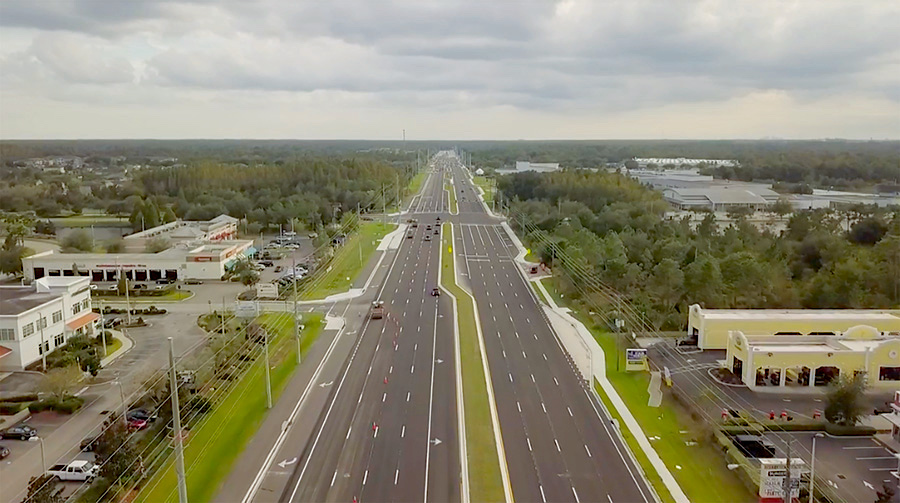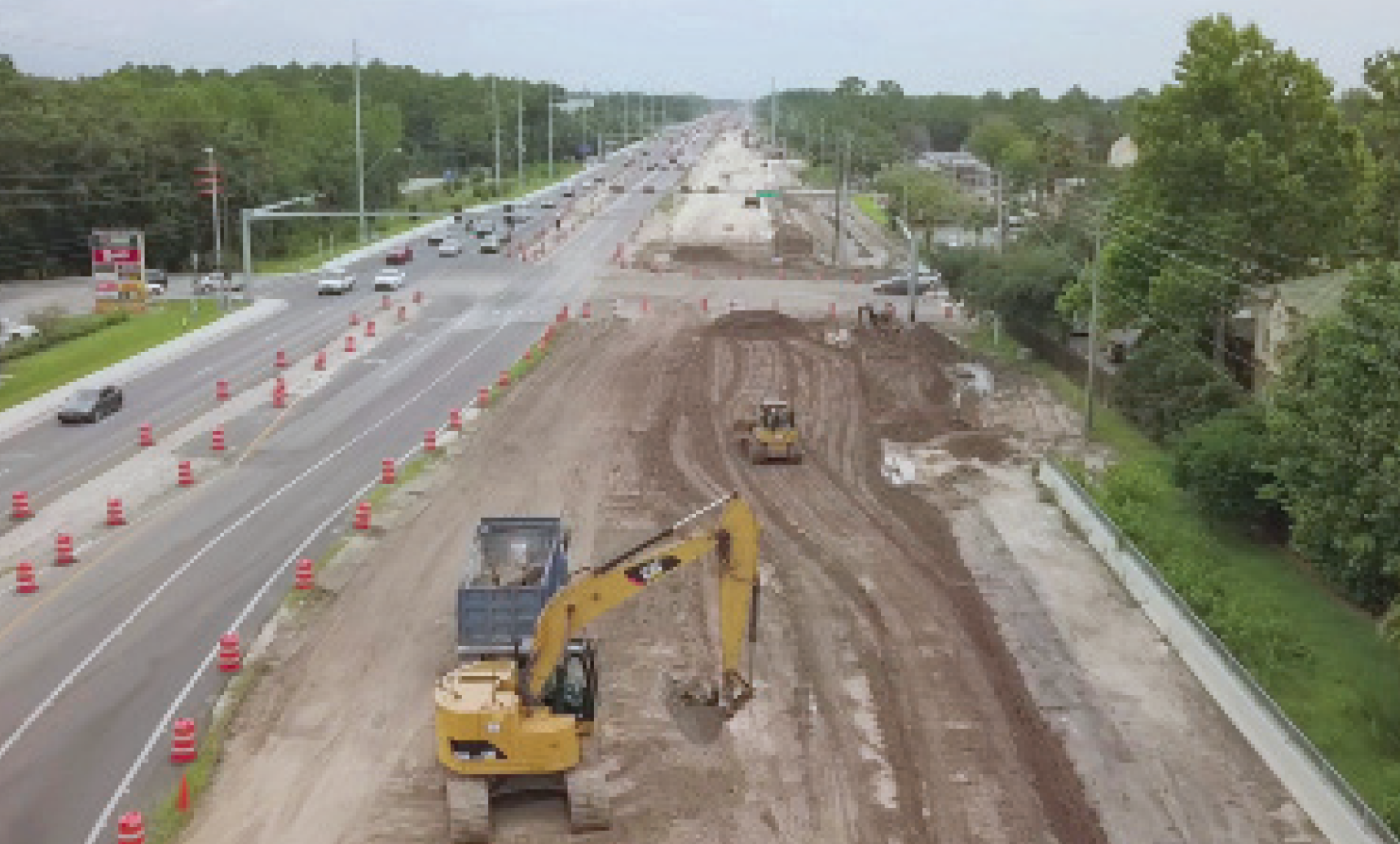Imagine being a traffic engineer for the Florida Department of Transportation (FDOT) and director of public works in Hillsborough County for 29 years, going to work, designing traffic layouts and signals to help traffic flows in 14 Florida counties.
Imagine doing your highly stressful job so well and acquiring so many admirers along the way, that when you suddenly pass away, it is so heartbreaking that they re-name a road in your honor.
Now, imagine your name is Bruce Barkley Downs.
• • •
In New Tampa, you won’t have Bruce B. Downs to kick around much longer, as the widening of the much-maligned, and breathlessly-besmirched boulevard that bears the late Mr. Downs’ name is now — finally — complete.
But, not completely complete, mind you.

There is still a light to install at Trout Creek Dr., which was determined to be a need after the project began. There also are a few patches here and there that need to be smoothed out, and trees and other aesthetic elements to put into place.
As we went to press with this issue, just before Thanksgiving, there were portions of a few northbound lanes receiving their final paving layers, and some of those dreaded and all-too-familiar orange cones are lying around. But, by the time this issue hits mailboxes, we are told they will have vanished.
All eight lanes — eight! — of Bruce B. Downs, for all intents and purposes, are finally Bruce B. Done.
“It’s good to finally get the last piece done,” says Jim Hudock, Hillsborough County’s Public Works director, the same job Downs once held.
• • •
The project was a big one, right from the start. Though construction actually began in 2010, the decade before that was filled with discussions and planning and petitions and angry residents, but for years, no money to do anything.
What was formerly N. 30th St. before being named for Bruce B. Downs in 1986, what is now New Tampa’s primary artery, used to be called the “Road To Nowhere,” a seemingly endless stretch of road that ran all the way north to S.R. 54, where it dead-ended at a stack of concrete cinder blocks in someplace called Wesley Chapel.

“I remember taking friends home that lived in Pebble Creek, and it seemed like three counties north of here,” says Ken Hagan, who was elected as the Hillsborough County District 2 commissioner representing the New Tampa area after serving in the same role in the county-wide District 5 seat the last five years.
Hagan remembers drag racing on the “Road To Nowhere,” before it was even fully paved, when he attended Chamberlain High School on Busch Blvd., as his father did before him.
But, New Tampa was exploding — and northern neighbor Wesley Chapel wasn’t too far behind — and it was obvious to everyone that lived here that our main thoroughfare was not going to be able to handle all of that growth.
“That’s why it was always No. 1 on our unfunded list,” says Hagan, adding that he has worked diligently since entering public life to secure more than $100-million for the project. “The road was not initially constructed to hold the existing capacity, much less the growth that was undoubtedly going to occur. Hopefully, we have learned from those mistakes.”
Wishful thinking, perhaps? M/I Homes was recently approved to build 400 more homes in the K-Bar Ranch community, which has only one road out of it and could face similar problems with old, outdated “country roads” like Morris Bridge Rd. in the future.
• • •
The $131-million, 8.5-mile-long widening of BBD, the largest and most expensive of any similar project in Hillsborough County’s history, was done in four segments, and the first — Segments B and C together — was a 3.4-mile stretch from Palm Springs Blvd. in Tampa Palms north to Pebble Creek Dr.
Segments B & C were the hardest segments, with more than 60,000 daily vehicle trips and the I-75 interchange to contend with, and ended up costing $52.3 million.

Segment A followed in 2015, and would cost $54.7 million to transform four and six lanes running from Palm Springs Blvd. south to E. Bearss Ave. into eight glorious lanes.
That last piece, Segment D, began construction in 2016, following a lightly attended public information meeting at Wharton High on Oct. 18.
While many of the businesses along the corridor suffered from lingering construction at their entrances and issues arose with various underground utilities, the high school was both one of the biggest obstacles — and concerns — of New Tampa residents.
“It took a little bit of coordination with the school, and the School Board was great about working with us,” Hudock said. “Anytime you do a construction project, there is going to be some challenges. This required a lot of hard work from a lot of different agencies. There was a lot of land acquisition; businesses had to work with us out there. We are excited to have it all open, and are hopeful that a lot of the lessons we learned in that corridor can be applied to future projects.”
Hudock has heard all of the complaints. He said his department tried to investigate specific issues that were reported, and worked hard at replying to customer service requests.
• • •
Bruce Barkley Downs, after retiring from FDOT, became Hillsborough’s director of Public Works & Safety and the deputy county administrator. According to a 2007 story in the then-St. Petersburg Times, he was in charge of 2,100 miles of roads and bridges.
In 1983, a local newspaper (yes, it pre-dates the Neighborhood News) wrote a story about Downs, stating he had the most stressful job in the county. The day the story came out, Downs, who battled high blood pressure his entire life, collapsed while having lunch with co-workers. He had suffered a major heart and passed away at the age of 53.
On April 17, 1986, on his birthday, the county renamed 30th St. between E. Fowler Ave. and the county line “Bruce B. Downs Blvd.”
It is the main thoroughfare for the University of South Florida, New Tampa and Wesley Chapel. It also has been regarded as one of the most notoriously frustrating roadways in all of Tampa Bay.
Worst traffic? The #1 road to avoid? Everything that’s wrong with government planning?
Bruce B. Downs.
Known for his reputation for helping people and his love of roads and making them work, the man for whom the road is named would likely be pleased to see a project like this one finally completed.
So surely, the completion of the widening of that road, along with the bicycle and pedestrian enhancements and intersection improvements, deserves some kind of celebration.
A ribbon cutting? A cake? A concert by BBD (the group Bell Biv DeVoe)?
“Really, it’s about thanking everybody for the hard work and moving on to the next project,” Hudock said. “But this being as big a project as it was, there may be some consideration for something more.”








